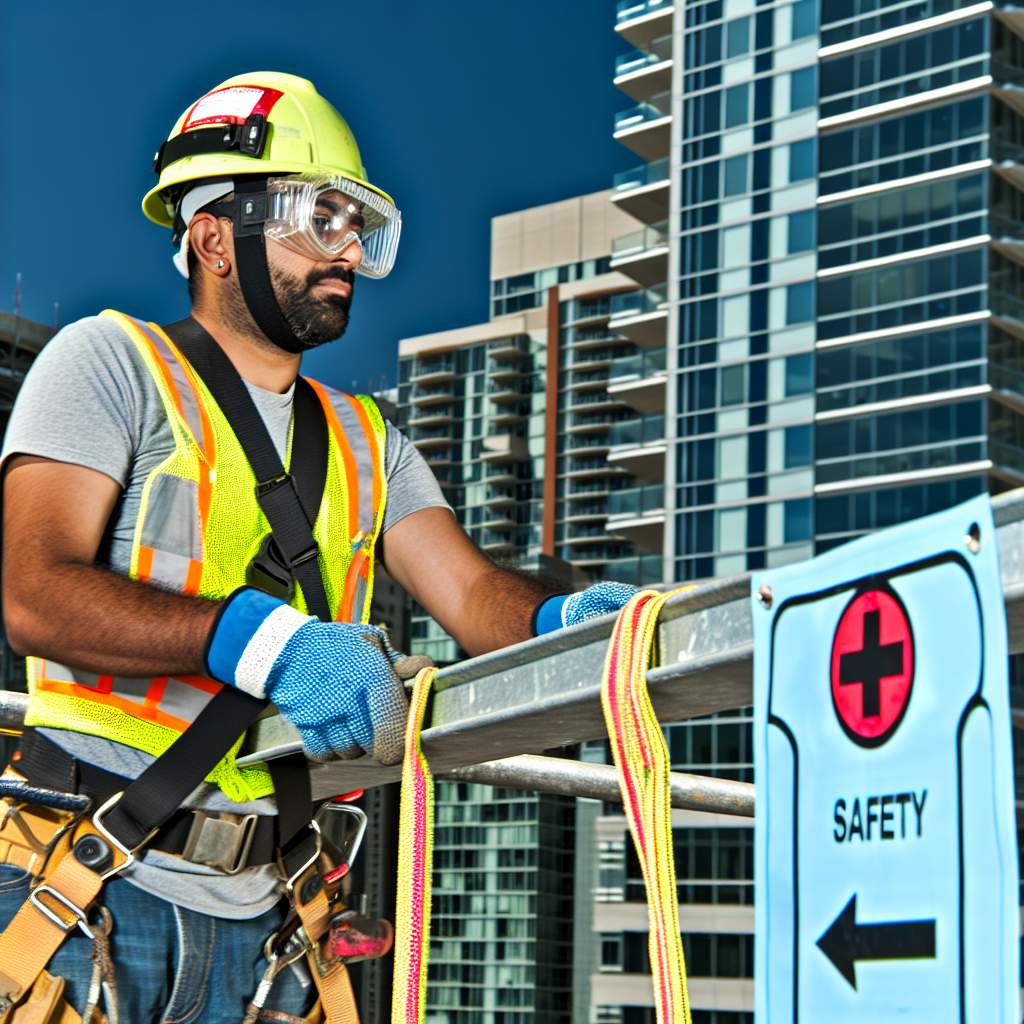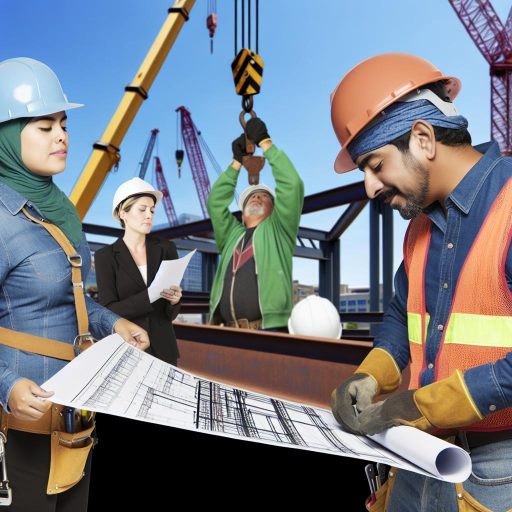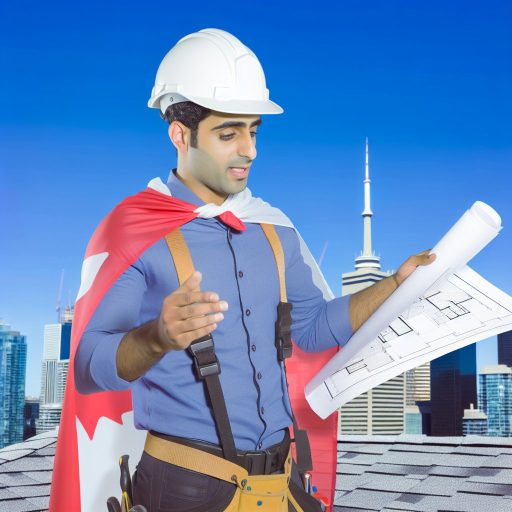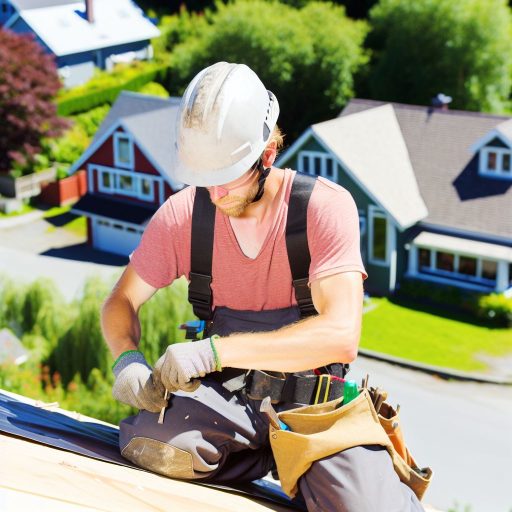Understanding Personal Protective Equipment (PPE) for Ironworkers
Importance of PPE
Wearing proper PPE is crucial for ironworkers on construction sites.
This equipment protects against various hazards present at the job site.
Additionally, it significantly reduces the risk of injuries and accidents.
Types of PPE
- Helmets are fundamental in protecting against falling objects.
- Safety glasses shield the eyes from dust and debris.
- Gloves offer hand protection when handling sharp materials.
- Steel-toed boots provide essential foot protection.
- High-visibility vests ensure workers are seen in busy environments.
- Harnesses are critical for safety when working at heights.
Choosing the Right PPE
Selecting the correct PPE depends on the specific tasks performed.
Evaluate the hazards present at the job site before choosing equipment.
Consult with safety officers for recommendations tailored to the work environment.
Proper Maintenance of PPE
Regular maintenance of PPE ensures its effectiveness and longevity.
Inspect equipment for wear and tear before each use.
Clean helmets and safety glasses to maintain visibility and effectiveness.
Store PPE properly to prevent damage when not in use.
Training on PPE Use
Training is essential for all workers regarding the proper use of PPE.
Conduct workshops that emphasize how to wear and maintain equipment.
Encourage questions to clarify doubts about PPE use among ironworkers.
Importance of Fall Protection Systems and How to Use Them
Understanding Fall Hazards
Construction sites pose significant fall hazards for ironworkers.
Working at heights increases the risk of serious injuries or fatalities.
Identifying these hazards is the first step towards safety.
Recognizing Fall Protection Systems
Fall protection systems are essential for maintaining safety on sites.
These systems include guardrails, safety nets, and personal fall arrest systems.
Choosing the right system depends on the job specifics and site conditions.
Utilizing Personal Fall Arrest Systems
Personal fall arrest systems (PFAS) provide critical protection while working at heights.
PFAS typically includes harnesses, lanyards, and anchor points.
Always ensure the harness fits properly and is adjusted securely.
Implementing Guardrails and Safety Nets
Guardrails create a physical barrier to prevent falls.
Installing guardrails around elevated platforms is a simple yet effective measure.
Safety nets capture falling workers and debris, minimizing injury risks.
Unlock Your Career Potential
Visualize a clear path to success with our tailored Career Consulting service. Personalized insights in just 1-3 days.
Get StartedConducting Safety Training
Training is vital for effective use of fall protection systems.
Regularly scheduled training helps ironworkers stay informed about safety protocols.
Encourage a safety culture where employees look out for one another.
Regular Inspection and Maintenance
Regular inspections ensure all fall protection systems remain functional.
Check equipment daily before use to identify any wear or damage.
Address any issues immediately to maintain a safe working environment.
Emergency Response Planning
Having an emergency response plan is crucial for construction sites.
Workers should know how to react in case of a fall or accident.
Regular drills can help prepare everyone for emergency situations.
Recognizing and Mitigating Hazards in Elevated Work Areas
Identifying Common Hazards
Ironworkers often face unique risks at elevated work sites.
Falling from heights is one of the most severe hazards.
Working with heavy materials can lead to crushing injuries.
Additionally, electrical hazards pose significant threats.
Recognizing these risks is the first step in prevention.
Implementing Safety Protocols
Establish comprehensive safety protocols to combat identified hazards.
Use fall protection systems, such as guardrails and harnesses.
Regular training ensures all workers understand necessary procedures.
Employ a buddy system to enhance worker safety during operations.
Monitoring and evaluation of safety measures is crucial.
Utilizing Personal Protective Equipment
Wearing appropriate personal protective equipment is vital.
Helmets protect against falling objects and head injuries.
Steel-toed boots offer foot protection on construction sites.
High-visibility vests help workers remain visible to others.
Ensure that all protective gear fits correctly for maximum effectiveness.
Regular Safety Inspections
Conduct frequent inspections of work areas and equipment.
This helps identify potential hazards before they lead to accidents.
Document findings and take corrective actions promptly.
Engage workers in identifying hazards during inspections.
Continuous improvement fosters a safer work environment.
Emergency Preparedness
Prepare for emergencies by creating an action plan.
Ensure all workers know evacuation routes and procedures.
Regular drills enhance readiness for a variety of scenarios.
Designate emergency contacts for immediate assistance.
Stay updated on local emergency services and resources.
Gain More Insights: Common Challenges Faced by HVAC Technicians
Safe Use of Lifting Equipment and Rigging Practices
Understanding Proper Equipment Usage
Ironworkers must understand the capabilities of lifting equipment.
They should only use equipment that is rated for the specific load.
In addition, workers must know weight limits and safety factors.
Regular inspections by qualified personnel ensure safety and performance.
Selecting the Right Rigging Gear
Choosing the appropriate rigging gear is essential for safety.
Always select gear that meets industry standards and regulations.
Be aware of the various types of rigging equipment available.
For instance, slings, shackles, and hooks each serve different purposes.
Using gear incorrectly can result in dangerous accidents.
Conducting Thorough Inspections
Inspect all lifting equipment and rigging gear before use.
Look for signs of wear, damage, or corrosion in the equipment.
Report any defects immediately to a supervisor or safety officer.
Document inspections to maintain compliance and accountability.
Implementing Safe Work Practices
Always follow established protocols when using lifting equipment.
Make sure to communicate effectively with team members.
Establish clear signals for lifting and lowering loads.
Never work under a suspended load unless absolutely necessary.
Maintain a safe distance from loads during lifting operations.
Training and Certification
Interactive training programs enhance safety awareness among workers.
Ensure all personnel receive training on equipment and safety practices.
Certification in rigging and lifting operations often proves beneficial.
Regular updates and refresher courses keep skills sharp and relevant.
Recognizing and Addressing Hazards
Every ironworker must recognize potential hazards on site.
Stay vigilant for overhead hazards when using lifting equipment.
Identify and mark areas where danger exists to alert others.
Be proactive in reporting unsafe conditions to site management.
Utilizing Protective Equipment
Always wear appropriate personal protective equipment (PPE) while working.
This includes hard hats, gloves, and steel-toed boots, among others.
PPE helps safeguard against potential injuries during operations.
Consistent use of PPE promotes a culture of safety on site.
See Related Content: Common Challenges Faced by Professional Upholsterers
Implementing Effective Communication Strategies Among Crew Members
Creating a Culture of Open Dialogue
Encouraging open dialogue enhances safety on construction sites.
Workers should feel comfortable sharing concerns and suggestions.
Regular meetings can promote an open communication atmosphere.
Additionally, fostering trust among team members is crucial.
Utilizing Clear and Concise Language
Using clear language prevents misunderstandings during work tasks.
Everyone should understand instructions before proceeding.
Visual aids can help clarify complex instructions.
Furthermore, using simple terms reduces the risk of errors.
Implementing Safety Signals and Signage
Establishing clear safety signals is essential for coordination.
Visual signs should be posted in visible locations around the site.
Red flags can indicate hazardous areas, ensuring worker awareness.
Regularly reviewing and updating signage keeps information fresh.
Encouraging Team Briefings and Debriefings
Daily briefings prepare crew members for the day’s tasks.
During these sessions, discuss safety protocols and potential hazards.
Debriefing at the end of the day helps assess what worked well.
It also allows the team to address any safety incidents promptly.
Promoting Peer-to-Peer Communication
Encouraging peer-to-peer communication enhances overall safety.
Workers should watch out for one another on the job site.
Establishing buddy systems can foster stronger team bonds.
Additionally, this approach enables quicker responses to dangers.
You Might Also Like: Green Roofing and Opportunities for Canadian Roofers

Conducting Regular Safety Inspections and Site Assessments
Importance of Regular Inspections
Regular inspections help maintain a safe work environment for ironworkers.
They identify potential hazards before they cause accidents.
Additionally, inspections promote compliance with safety regulations.
Establishing a Safety Inspection Schedule
Create a consistent inspection schedule for all construction sites.
Include daily, weekly, and monthly checks for various safety aspects.
Ensure all staff are aware of the inspection schedule and procedures.
Key Elements to Inspect
Examine all safety equipment thoroughly and regularly.
Check that scaffolding and ladders are secure and well-maintained.
Look for loose materials, debris, or other trip hazards on-site.
Ensure proper signage is in place to alert workers to hazards.
Evaluate fall protection systems for effectiveness and compliance.
Engaging Employees in Safety Inspections
Involve ironworkers in the inspection process for better results.
Encourage them to report safety issues immediately.
Hold training sessions to educate workers on inspection protocols.
Foster a culture where safety concerns are taken seriously.
Documenting Findings and Actions
Document all inspection findings for future reference.
Establish a protocol for rectifying identified issues promptly.
Share inspection results with all team members regularly.
Use documentation to improve overall safety strategies.
Uncover the Details: Effective Marketing Strategies for Upholstery Services
Training and Certification Requirements for Ironworkers
Importance of Training
Training prepares ironworkers for safe operations on construction sites.
Additionally, it equips them with essential skills and knowledge.
Effective training reduces the risk of accidents and injuries.
Certification Programs
Certification programs provide formal recognition of skills and expertise.
Various organizations offer certification for ironworkers.
For example, the National Center for Construction Education and Research (NCCER) provides a comprehensive program.
Certification ensures workers meet industry safety and skills standards.
Required Safety Training
All ironworkers must undergo specific safety training courses.
Common courses include fall protection, scaffolding safety, and rigging practices.
Participating in hands-on training enhances understanding and retention.
Continuous Education
Ironworkers should engage in continuous education programs.
These programs help workers stay updated on safety regulations.
Furthermore, ongoing education encourages skill enhancement.
On-the-Job Training
On-the-job training provides practical experience in a real work environment.
It allows ironworkers to learn from seasoned professionals.
Mentorship programs can strengthen safety practices among new workers.
Verification of Skills
Employers typically require proof of training and certification.
This verification helps ensure a skilled and knowledgeable workforce.
It also fosters a culture of safety throughout the construction site.
Emergency Response Preparedness and First Aid Training
Importance of Emergency Preparedness
Emergency preparedness is vital in construction environments.
Workers must know how to react during unexpected situations.
Quick action can save lives and reduce injuries.
Creating an Emergency Response Plan
Develop a comprehensive emergency response plan.
This plan should include evacuation routes and assembly points.
Ensure all workers understand their roles during an emergency.
Practice drills regularly to reinforce training.
First Aid Training for Ironworkers
First aid training is crucial for all construction site workers.
Workers should learn to respond to common injuries.
Consider certifications from recognized organizations.
This can enhance the team’s overall safety skills.
Identifying Emergency Equipment
Identify and maintain emergency equipment at the job site.
Everyone should know the location of first aid kits.
Fire extinguishers and defibrillators must be easily accessible.
Regular checks ensure that equipment is functional and ready.
Communicating Emergency Procedures
Clear communication of emergency procedures is essential.
Display emergency procedures prominently on site.
Hold meetings to discuss and review these procedures.
Encourage workers to ask questions about emergency protocols.
Managing Stress During Emergencies
Managing stress during emergencies can improve outcomes.
Train workers in stress management techniques.
Encourage teamwork to enhance support during crises.
Promote a culture of safety and preparedness.
Additional Resources
Do construction workers still get paid if it rains and snows to the …
Safety Standards for Steel Erection | Occupational Safety and Health …




